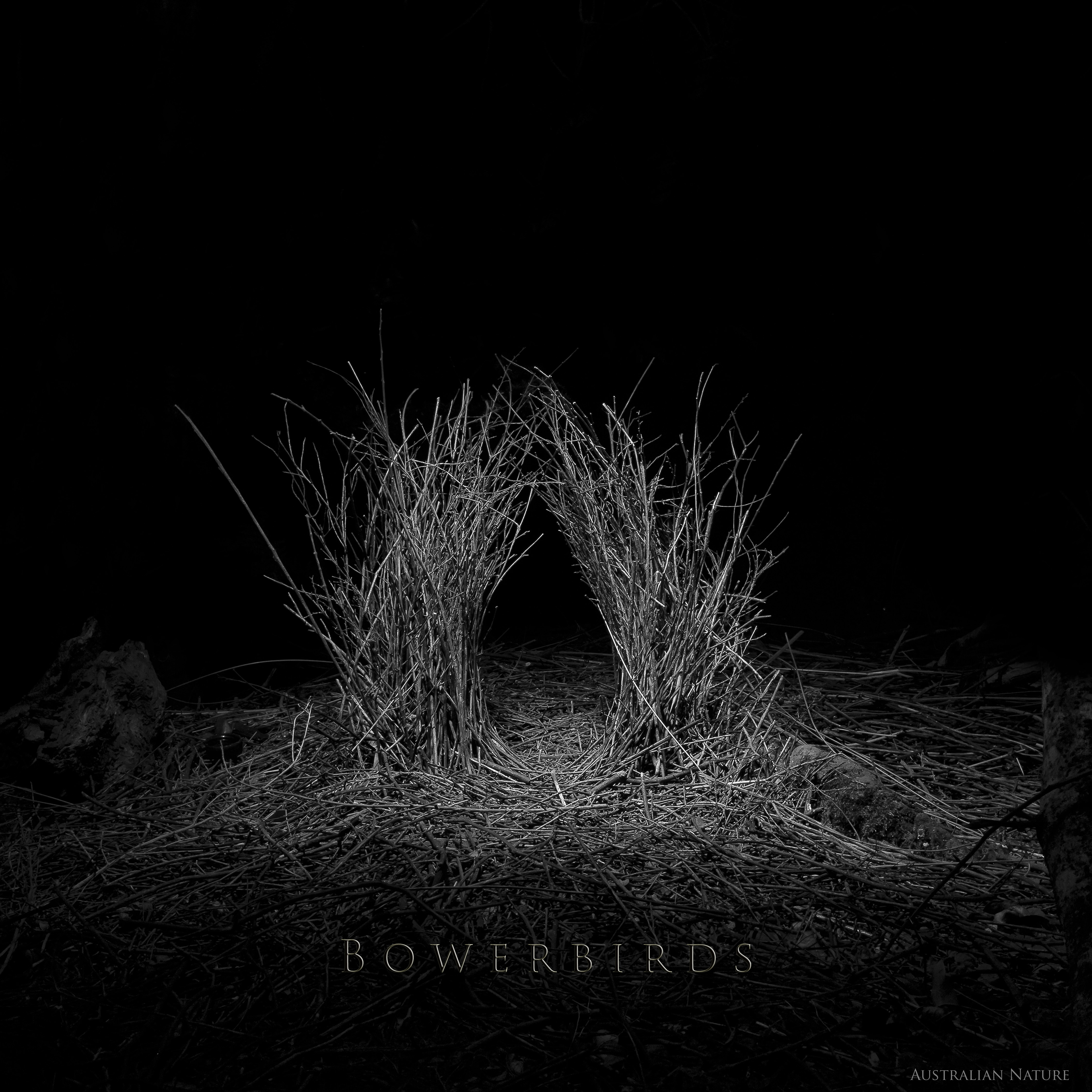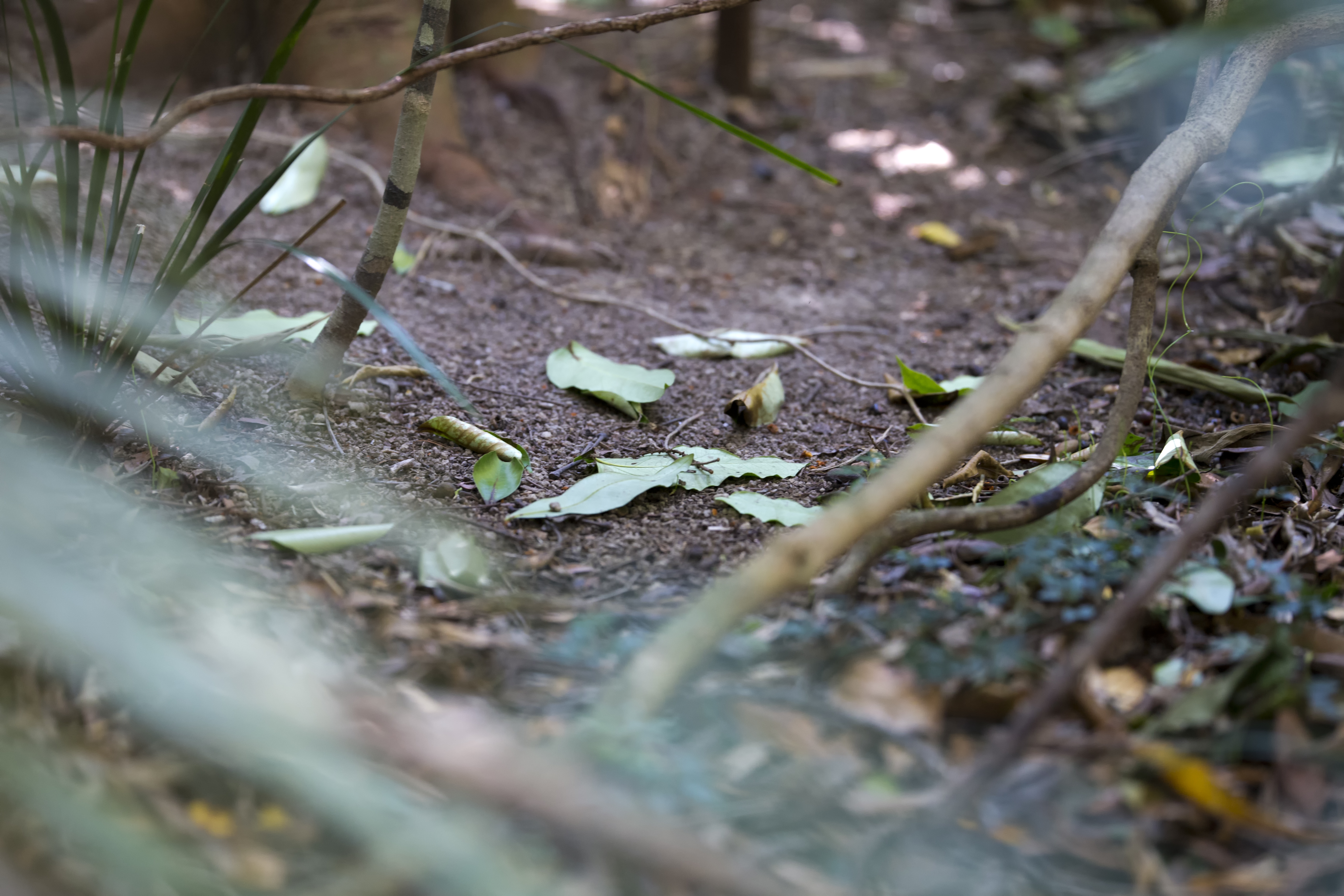|
Bowerbird
Bowerbirds () make up the bird family Ptilonorhynchidae. They are renowned for their unique courtship behaviour, where males build a structure and decorate it with sticks and brightly coloured objects in an attempt to attract a mate. The family has 27 species in eight genera. These are medium to large-sized passerines, ranging from the golden bowerbird at and to the great bowerbird at and . Their diet consists mainly of fruit but may also include insects (especially for nestlings), flowers, nectar and leaves in some species. The satin and spotted bowerbirds are sometimes considered agricultural pests due to their habit of feeding on introduced fruit and vegetable crops and have occasionally been killed by affected orchardists. The bowerbirds have an Austro-Papuan distribution, with ten species endemic to New Guinea, eight endemic to Australia, and two found in both. Although their distribution is centered on the tropical regions of New Guinea and northern Australia, some sp ... [...More Info...] [...Related Items...] OR: [Wikipedia] [Google] [Baidu] |
Spotted Bowerbird
The spotted bowerbird (''Chlamydera maculata'') is a sedentary, mid-sized passerine found across broad parts of the drier habitats of eastern Australia. The species is known for its remarkable behaviours, like many other bowerbirds (Ptilonorynchidae), which include bower building and decorating, courtship displays and vocal mimicry. Spotted bowerbirds are locally common, however, overall the population is thought to be in decline. Description At 29 cm in length, spotted bowerbirds are intermediate in size among the bowerbirds, but are rather slim and compact. Spotted bowerbirds are sexually monomorphic, with a pale rufous head that is streaked with grey-brown and a nape adorned with a lilac-pink crest. The upperparts are blackish-brown and marked extensively with amber spots, while the paler underparts are cream with greyish scalloping and barring and a slightly yellow shade to the lower belly and undertail. The bill is black, the eyes dark brown and the legs olive-brown. ... [...More Info...] [...Related Items...] OR: [Wikipedia] [Google] [Baidu] |
Satin Bowerbird
The satin bowerbird (''Ptilonorhynchus violaceus'') is a bowerbird endemic to eastern Australia. A rare natural hybrid (biology), intergeneric hybrid between the satin bowerbird and the regent bowerbird is known as Rawnsley's bowerbird. Description Mature males have violet-blue eyes and are uniformly coloured black, however, light diffraction by the surface texture of the feathers results in an almost metallic sheen giving a deep shiny blue appearance. Immature males are coloured and marked the same as females and are often mistaken for them. Females might be mistaken for the green catbird or spotted catbird with distinctively green/brown or otherwise entirely brown upper body and lighter under body with a distinct reticulated or scalloped pattern, but with very striking blue eyes. Distribution The satin bowerbird is common in rainforest and tall wet sclerophyll forest in eastern Australia from southern Queensland to Victoria (Australia), Victoria. There is also an isolated po ... [...More Info...] [...Related Items...] OR: [Wikipedia] [Google] [Baidu] |
Ptilonorhynchus
The satin bowerbird (''Ptilonorhynchus violaceus'') is a bowerbird endemic to eastern Australia. A rare natural intergeneric hybrid between the satin bowerbird and the regent bowerbird is known as Rawnsley's bowerbird. Description Mature males have violet-blue eyes and are uniformly coloured black, however, light diffraction by the surface texture of the feathers results in an almost metallic sheen giving a deep shiny blue appearance. Immature males are coloured and marked the same as females and are often mistaken for them. Females might be mistaken for the green catbird or spotted catbird with distinctively green/brown or otherwise entirely brown upper body and lighter under body with a distinct reticulated or scalloped pattern, but with very striking blue eyes. Distribution The satin bowerbird is common in rainforest and tall wet sclerophyll forest in eastern Australia from southern Queensland to Victoria. There is also an isolated population in the Wet Tropics of north Qu ... [...More Info...] [...Related Items...] OR: [Wikipedia] [Google] [Baidu] |
Golden Bowerbird
The golden bowerbird (''Prionodura newtoniana'') is a species of bird in the family Ptilonorhynchidae, the bowerbirds. It is endemic to Queensland in Australia, where it is limited to the Atherton region. Distribution This species has a patchy distribution in northeastern Queensland. Though it has a limited range, it is common in the area, and populations are apparently stable. It is a least-concern species on the IUCN Red List. This bird lives in rainforests above 700 meters in elevation, including some habitat that has been disturbed by human activities such as logging. Description The male golden bowerbird has a brown head and brown wings which are bright yellow-gold underneath, as are the tail, crest and nape. The female is olive brown with ash-gray underparts. Immatures look similar to the female except their eyes are brown. This is the smallest species of bowerbird. Habitat The habitat of the golden bowerbird is upland rainforests from 350 and 1530 meters. Tradit ... [...More Info...] [...Related Items...] OR: [Wikipedia] [Google] [Baidu] |
Great Bowerbird
The great bowerbird (''Chlamydera nuchalis'') is a common and conspicuous resident of northern Australia, from the area around Broome across the Top End to Cape York Peninsula and as far south as Mount Isa. Favoured habitat is a broad range of forest and woodland, and the margins of vine forests, monsoon forest, and mangrove swamps. As with most members of the bowerbird family, breeding considerations dominate the lifecycle: females nest inconspicuously and raise their young alone, while the males spend most of the year building, maintaining, improving, defending, and above all displaying from their bowers. Only a male with a successful bower can attract mates. The great bowerbird is the largest of the bowerbird family and is 33 to 38 cm long and fawny grey in colour. Males have a small but conspicuous pink crest on the nape of the neck. Bower The bower is a twin-walled avenue-type bower approximately 1 metre long and 45 cm high. It is typically located under a shrub ... [...More Info...] [...Related Items...] OR: [Wikipedia] [Google] [Baidu] |
Tooth-billed Bowerbird
The tooth-billed bowerbird (''Scenopoeetes dentirostris''), also known as the stagemaker bowerbird or tooth-billed catbird, is a medium-sized (approximately long) bowerbird. It is a stocky olive-brown bird with brown-streaked buffish white underparts, grey feet, a brown iris and a distinctive serrated bill. Both sexes are similar, but the female is slightly smaller than the male. It is the only member of the genus ''Scenopoeetes''. The tooth-billed bowerbird is endemic to the mountain forests of northeast Queensland, Australia. Its diet consists mainly of fruits and young leaves of forest trees. The male is polygamous and builds a display-court or "stage-type bower" (hence the alternate name stagemaker), decorated with fresh green leaves laid with their pale undersides facing up. The leaves are collected by the male by chewing through the leaf stalk and old leaves are removed from the display-court. The display-court consists of a cleared area containing at least one tree tr ... [...More Info...] [...Related Items...] OR: [Wikipedia] [Google] [Baidu] |
Amblyornis
''Amblyornis'' is a genus of bowerbirds belonging to the family Ptilonorhynchidae. Established by Daniel Giraud Elliot in 1872, it contains five species: Species The name ''Amblyornis'' is a combination of the Greek Greek may refer to: Greece Anything of, from, or related to Greece, a country in Southern Europe: *Greeks, an ethnic group. *Greek language, a branch of the Indo-European language family. **Proto-Greek language, the assumed last common ancestor ... words ''amblus'', meaning "dull" and ''ornis'', meaning "bird". References Bird genera {{passeri-stub ... [...More Info...] [...Related Items...] OR: [Wikipedia] [Google] [Baidu] |
Sericulus
The genus ''Sericulus'' of the family Ptilonorhynchidae consists of four spectacularly colored bowerbirds. All species build an ''"avenue-type"'' bower and are found in New Guinea New Guinea (; Hiri Motu: ''Niu Gini''; id, Papua, or , historically ) is the world's second-largest island with an area of . Located in Oceania in the southwestern Pacific Ocean, the island is separated from Australia by the wide Torr ... and Australia. Species References Bird genera {{passeri-stub ... [...More Info...] [...Related Items...] OR: [Wikipedia] [Google] [Baidu] |
Chlamydera
''Chlamydera'' is a genus of bird in the family Ptilonorhynchidae. Species All species found in Australia and/or New Guinea: * Fawn-breasted bowerbird (''Chlamydera cerviniventris'') * Western bowerbird (''Chlamydera guttata'') * Great bowerbird (''Chlamydera nuchalis'') * Yellow-breasted bowerbird The yellow-breasted bowerbird (''Chlamydera lauterbachi'') also known as Lauterbach's bowerbird, is a medium-sized, approximately 27 cm long, bowerbird with a brownish-olive upperparts plumage, grayish-yellow upper breast, coppery crown, dar ... (''Chlamydera lauterbachi'') * Spotted bowerbird (''Chlamydera maculata'') Bird genera Taxonomy articles created by Polbot {{passeri-stub ... [...More Info...] [...Related Items...] OR: [Wikipedia] [Google] [Baidu] |
Archboldia
''Archboldia'' is a genus of bowerbirds in the family Ptilonorhynchidae. Species *''Archboldia papuensis'' - Archbold's bowerbird. *''Archboldia sanfordi'' - Sanford's bowerbird Sanford's bowerbird (''Archboldia sanfordi'') is a subspecies of the Archbold's bowerbird. The Sanford's bowerbird is a black bowerbird with a reddish-brown iris, grey feet and black bill. The male has a golden crest extending from forehead, b .... External links ITES Bird genera Taxa named by Austin L. Rand {{passeri-stub ... [...More Info...] [...Related Items...] OR: [Wikipedia] [Google] [Baidu] |
Passerine
A passerine () is any bird of the order Passeriformes (; from Latin 'sparrow' and '-shaped'), which includes more than half of all bird species. Sometimes known as perching birds, passerines are distinguished from other orders of birds by the arrangement of their toes (three pointing forward and one back), which facilitates perching. With more than 140 families and some 6,500 identified species, Passeriformes is the largest clade of birds and among the most diverse clades of terrestrial vertebrates, representing 60% of birds.Ericson, P.G.P. et al. (2003Evolution, biogeography, and patterns of diversification in passerine birds ''J. Avian Biol'', 34:3–15.Selvatti, A.P. et al. (2015"A Paleogene origin for crown passerines and the diversification of the Oscines in the New World" ''Molecular Phylogenetics and Evolution'', 88:1–15. Passerines are divided into three clades: Acanthisitti (New Zealand wrens), Tyranni (suboscines), and Passeri (oscines or songbirds). The passeri ... [...More Info...] [...Related Items...] OR: [Wikipedia] [Google] [Baidu] |
Ailuroedus
''Ailuroedus'' is a genus of birds in the bowerbird family, Ptilonorhynchidae, native to forests in Australia and New Guinea. The common name, catbird, refers to these species' "wailing cat-like calls". The scientific name ''Ailuroedus'' is derived from the Greek 'ailouros', meaning cat, and 'eidos', referring to form (or perhaps from oaidos, singer). Description Catbirds are characterize by ivory-colored bill with the hooked maxilla, large head, green dorsal plumage, ventral spotting, powerful grasping claws and fig-eating habit. In contrast to the other genera within the ''Ptilonorhynchidae'' family, all of the ''Ailuroedus'' catbirds lack marked sexual dimorphism, are pair bonded, monogamous breeders, with both parents caring for the offspring. They form pair bonds in which the male helps to build the nest, and have simple arboreal chasing displays, without bowers or stages. Taxonomy Traditionally, the ''Ailuroedus'' catbirds were classified as three species. However ... [...More Info...] [...Related Items...] OR: [Wikipedia] [Google] [Baidu] |







.jpg)